This article will show you how to use SOU's VPN service to access our campus network remotely. VPN access must be approved through the Information Technology department before you can use the service or properly follow along with the instructions in this article. If you think you need VPN access, please contact your Computing Coordinator or email helpdesk@sou.edu.
If you receive a connection error after you install the OpenVPN Connect client and you have followed these instructions exactly, contact your Computing Coordinator right away. We have observed an issue where some computers running Windows 10 build 1803 cannot connect to our VPN service through the client. Updating to the latest build of Windows 10 fixes the issue, and your Computing Coordinator can guide you through that process if your device requires it.
FAQ
What is a VPN?
VPN stands for Virtual Private Network. A Virtual Private Network refers to a method of securely connecting remote computers to a host network over the Internet through a secure, encrypted tunnel. Computers connected to the SOU network over our VPN service appear on our network as though they were physically on campus even though they may be anywhere in the world, which makes all of our online campus resources available to them.
Is using the VPN service secure?
Yes, our VPN service is very secure. All of your data is encrypted between your computer and our servers as it travels over the Internet through the VPN tunnel. Using the VPN service is as safe as using your computer on our physical campus.
Is using the VPN service going to slow down my computer?
No, using the VPN service will not slow down your computer, but you may notice some latency in your web browsers or when you work with files on your P, S, or X drives because all of your data must travel over the Internet to our servers before anything else can happen. The latency should be very minor if you have a fast Internet connection. Unfortunately, there is nothing we can do to eliminate that latency because it will always take time for signals to travel over the distances involved in Internet transmission.
What should I do if my Internet connection is slow or unreliable?
We strongly recommend that you make arrangements to do your remote work where you can use the VPN service over a fast, reliable Internet connection. Talk to your Computing Coordinator if you think that is going to present a challenge.
What are the criteria for receiving approval to use the VPN service?
The IT Department evaluates requests for VPN access on a case-by-case basis. The following list of criteria is not exhaustive, nor is any single criterion both necessary and sufficient for approval, but hopefully the list will give you an idea of what we consider. Even if we determine that the VPN service is not the best solution for you, we will work with you to ensure that you have what you need to do your work remotely by other means.
- Your job duties require you to have access to secure online systems that can normally only be accessed while on campus, such as Banner, Cognos, EMS for scheduling, Millennium FAST, and Perceptive Content.
- Your job duties require you to use specialized software that would be impractical or impossible for us to make available through our Remote Desktop environments.
- Your job duties require you to use software that would not perform adequately on our Remote Desktop servers because of their processor, memory, or graphical processing requirements.
- You have a laptop that is managed by the IT Department that you can use with the VPN service. We are not authorizing VPN use from personal devices.
How to Install the VPN Service on Your Computer (FIRST TIME CONNECTING)
Follow these instructions to prepare your computer for connecting to the VPN service for the first time.
 Windows Instructions
Windows Instructions
Step 1 - Locate the Remote Access folder on your desktop
After you are approved for VPN access, you will receive a folder on your laptop's desktop titled RemoteAccess as long as you are on-campus. If you are off-campus, use this link to download a zipped copy of the folder that you can extract onto your desktop. The folder contains useful shortcuts for starting the VPN service and connecting to your SOU network drives (P, S, and X). If you cannot locate the folder, contact your Computing Coordinator for assistance.
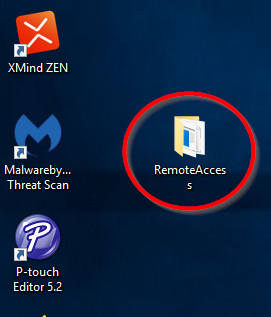
The RemoteAccess folder contains useful shortcuts to help you connect to the VPN service. If you are on Windows, you will find the following files in the RemoteAccess folder:
- ReadMe.txt - This file contains condensed instructions for how to connect to the VPN service and how to use the other items in the Remote Access folder.
- OpenVPN First Time Access - This is a shortcut to https://openvpn.sou.edu that will help you get started. It will open the webpage in your computer's default web browser.
- OpenVPN Connect - This shortcut will launch the OpenVPN software only after you have completed the instructions for first time setup. We will be using it later.
- MapNetworkDrives.cmd - This file is a batch script that will connect your computer to your Personal drive (P:) and your department Shared drive (S:) after you have connected to our network through the VPN service.
- MapCourseDrive.cmd - This file is a batch script that will connect your computer to your Courses drive (X:) after you have connected to our network through the VPN service. (Note: This drive is not relevant to staff, only to faculty.)
Step 2 - Launch the OpenVPN First Time Access shortcut, Sign In, and Install the OpenVPN Connect Client
The OpenVPN First Time Access shortcut will take you to our VPN sign-in page in your default web browser. Enter your SOU credentials and then click Sign In to continue.

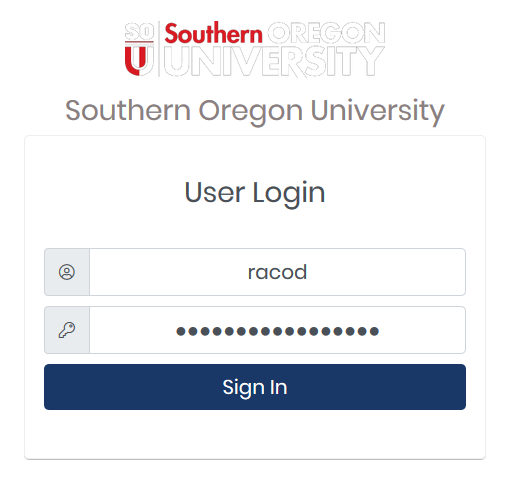
After you have provided your credentials, you will be required to complete your authentication with Duo. If you do not have a Duo device that you can access away from your office, contact your Computing Coordinator immediately or follow these instructions to self-enroll another Duo device, such as a cell phone or a home phone.
You may enter any of the following into the text field, then click Continue, to complete this step (don't include any quotation marks). If you have more than one phone enrolled in Duo, you can append "2" or "3" (or higher) to the push option, the sms option, and the phone option to refer to that device specifically. (Example: push2, phone2, sms2; push3, phone3, sms3) Because it is difficult to know which phone is identified by which number, we recommend that you start with no numbers, then append "2", then append "3" if "2" does not work, and so forth until you receive the push notification, the text message, or the phone call on whichever phone you have access to at the time.
- "push" - Enter this to receive a push notification from Duo on your enrolled smart phone.
- "sms" - Enter this to receive a text message from Duo on your enrolled smart phone or cell phone.
- "phone" - Enter this to receive a phone call from Duo on your enrolled smart phone, cell phone, or desk phone.
- token code - If you have a Duo token or want to use a passcode stored in the Duo app on your smart phone, enter the code in the text field.
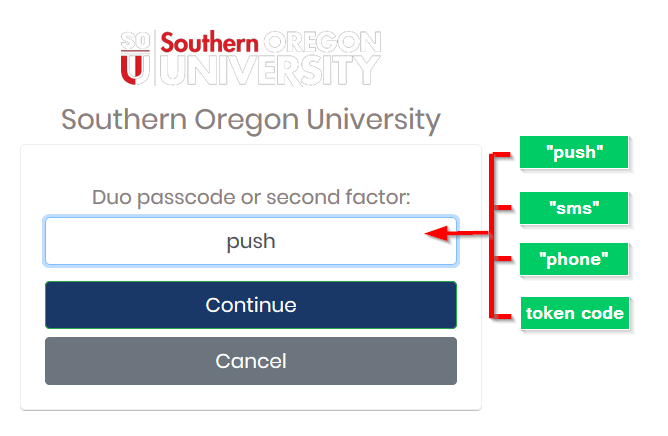
After you have successfully authenticated with Duo, the web page will prompt you to download the OpenVPN client for your computer's operating system. It should automatically recommend the right one for you. Click on the button featuring the logo for your operating system to begin the download.
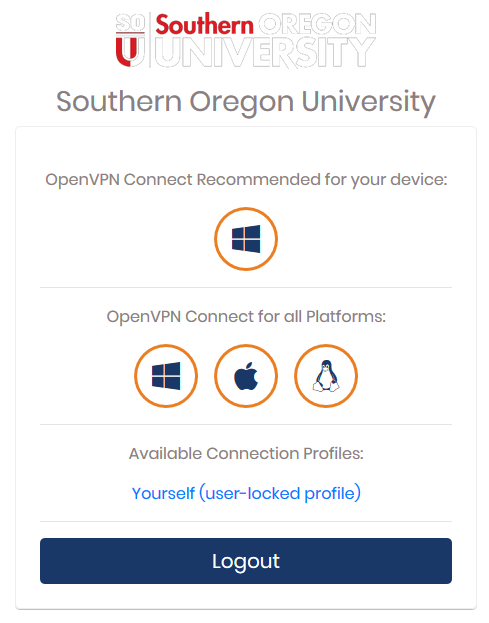
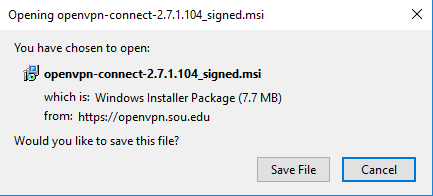
Find the downloaded installer on your computer and launch it. If you have any trouble installing the OpenVPN client, contact your Computing Coordinator.
 Macintosh Instructions
Macintosh Instructions
Step 1 - Navigate to https://openvpn.sou.edu and download the software
Open your favorite web browser on your Macintosh computer and navigate to https://openvpn.sou.edu. Enter your SOU credentials.

After you have provided your credentials, you will be required to complete your authentication with Duo. If you do not have a Duo device that you can access away from your office, contact your Computing Coordinator immediately or follow these instructions to self-enroll another Duo device, such as a cell phone or a home phone.
You may enter any of the following into the text field, then click Continue, to complete this step (don't include any quotation marks). If you have more than one phone enrolled in Duo, you can append "2" or "3" (or higher) to the push option, the sms option, and the phone option to refer to that device specifically. (Example: push2, phone2, sms2; push3, phone3, sms3) Because it is difficult to know which phone is identified by which number, we recommend that you start with no numbers, then append "2", then append "3" if "2" does not work, and so forth until you receive the push notification, the text message, or the phone call on whichever phone you have access to at the time.
- "push" - Enter this to receive a push notification from Duo on your enrolled smart phone.
- "sms" - Enter this to receive a text message from Duo on your enrolled smart phone or cell phone.
- "phone" - Enter this to receive a phone call from Duo on your enrolled smart phone, cell phone, or desk phone.
- token code - If you have a Duo token or want to use a passcode stored in the Duo app on your smart phone, enter the code in the text field.

After you have successfully authenticated with Duo, the web page will prompt you to download the OpenVPN client for your computer's operating system. It should automatically recommend the right one for you. Click on the button featuring the logo for your operating system to begin the download.
How to Connect to the VPN Service
If you have not yet configured your computer to connect to the VPN service, follow the instructions provided above. Follow the instructions below only after you have installed the OpenVPN Connect client on your computer.
 Windows Instructions
Windows Instructions
Step 1 - Launch the OpenVPN Connect client and connect to openvpn.sou.edu
You can conveniently launch the OpenVPN Connect client using the shortcut provided within the RemoteAccess folder on your desktop.

After you launch the client, you will need to locate its program icon in your Windows notification area icons and click it. Use the up arrow icon to show all of your hidden notification area icons if you do not see the orange OpenVPN Connect icon right away. (Tip: You can drag and drop the OpenVPN icon from the hidden icons to the "pinned" icons to keep it there permanently.)
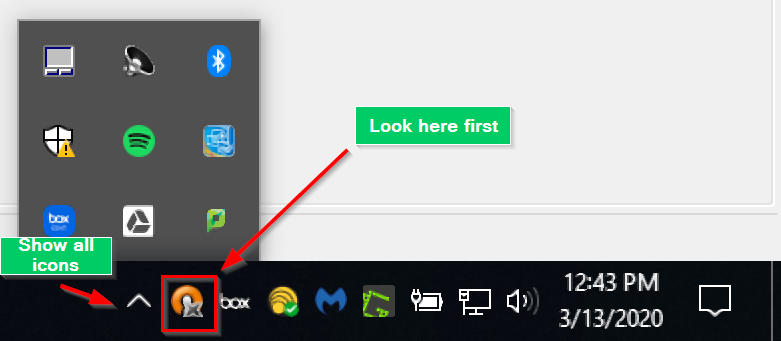
If this is your first time connecting or you see the "No VPN servers found" item in the menu after you click on the OpenVPN Connect client icon, then you need to click on Connect.
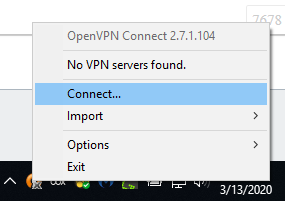
If you see openvpn.sou.edu in the menu already, click it, then click Connect in the submenu. This simply allows you to skip the next step below.
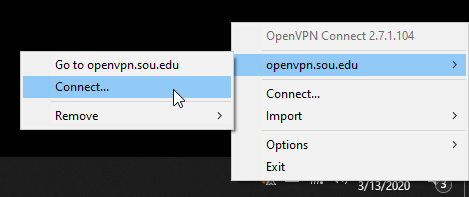
If prompted, enter "openvpn.sou.edu" into the text field for the hostname of the server, then click Continue.
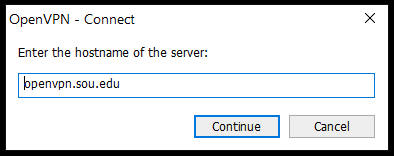
If you receive a connection error at this point, contact your Computing Coordinator right away. We have observed an issue where some computers running Windows 10 build 1803 cannot connect to our VPN service through the client. Updating to the latest build of Windows 10 fixes the issue, and your Computing Coordinator can guide you through that process if your device requires it.
Enter your SOU username and your SOU password, then click Connect.
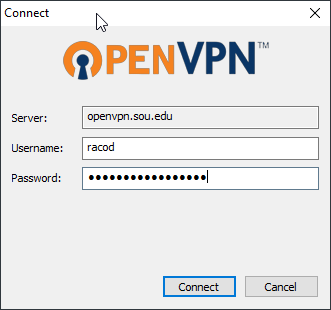
After you have provided your credentials, you will be required to complete your authentication with Duo. If you do not have a Duo device that you can access away from your office, contact your Computing Coordinator immediately or follow these instructions to self-enroll another Duo device, such as a cell phone or a home phone.
You may enter any of the following into the text field, then click Continue, to complete this step (don't include any quotation marks). If you have more than one phone enrolled in Duo, you can append "2" or "3" (or higher) to the push option, the sms option, and the phone option to refer to that device specifically. (Example: push2, phone2, sms2; push3, phone3, sms3) Because it is difficult to know which phone is identified by which number, we recommend that you start with no numbers, then append "2", then append "3" if "2" does not work, and so forth until you receive the push notification, the text message, or the phone call on whichever phone you have access to at the time.
- "push" - Enter this to receive a push notification from Duo on your enrolled smart phone.
- "sms" - Enter this to receive a text message from Duo on your enrolled smart phone or cell phone.
- "phone" - Enter this to receive a phone call from Duo on your enrolled smart phone, cell phone, or desk phone.
- token code - If you have a Duo token or want to use a passcode stored in the Duo app on your smart phone, enter the code in the text field.
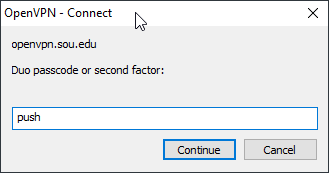
You should then see a message from Windows indicating that the VPN connection completed successfully. The OpenVPN Connect icon should also update with a green arrow to indicate that you are connected. Congratulations!
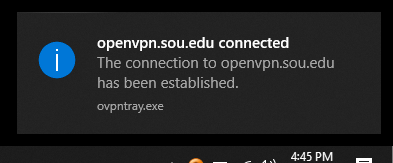

Step 2 - Connect Your SOU Network Drives (P, S, and X)
When you boot up your SOU laptop on campus, it automatically connects to your network drives for you because they are reachable. When you boot up your SOU laptop at home, it cannot reach the network drives yet, so it skips connecting to them. Now that you have connected to the VPN service, we can finally connect to your SOU network drives.
Connect to your P drive and the S drive
Double click the MapNetworkDrives.cmd script file in your RemoteAccess folder on your desktop. You should briefly see a command line window appear on your screen with some text in it. You can ignore the window. It will close on its own when the script finishes.

Connect to the X drive (for faculty)
Double click the MapCourseDrive.cmd script file in your RemoteAccess folder on your desktop. You should briefly see a command line window appear on your screen with some text in it. You can ignore the window. It will close on its own when the script finishes.
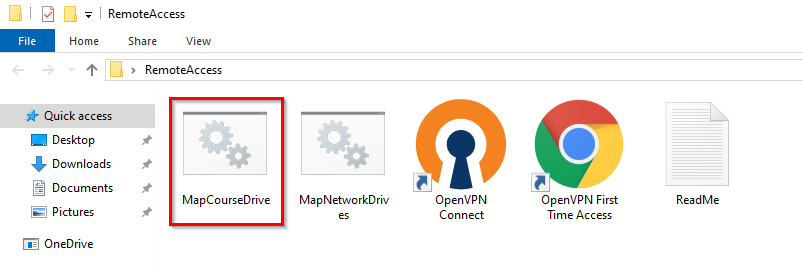
Verify that the drives connected
You should see them in the quick access columns along the left side of the File Explorer window where you just ran the scripts. You can now access them as you normally would at work.
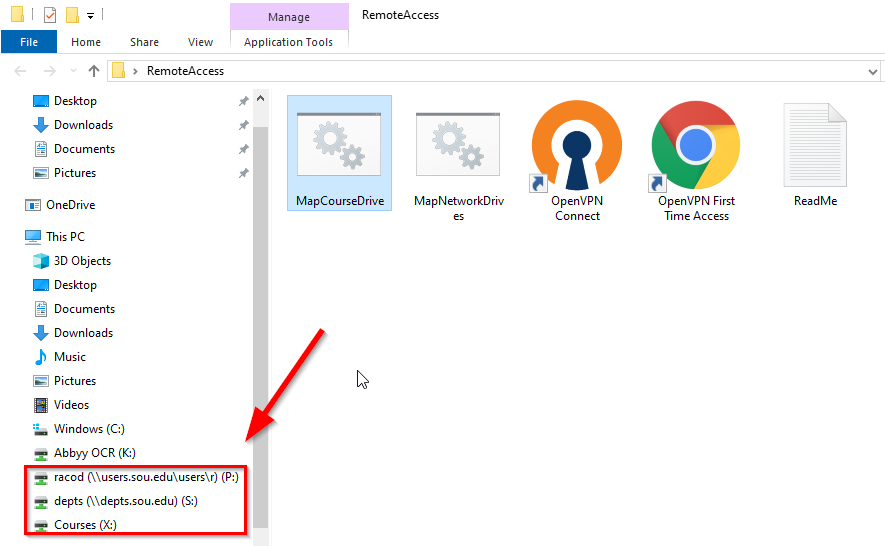
 Macintosh Instructions
Macintosh Instructions
Step 1 - Launch the OpenVPN Connect client and connect to openvpn.sou.edu
You will find the OpenVPN Connect client in your Applications folder. Launch it, then look for the OpenVPN Connect icon in your menu bar near your system clock in the top-right region of your screen.
Click on the menu bar icon for OpenVPN Connect and then select Connect from the menu.
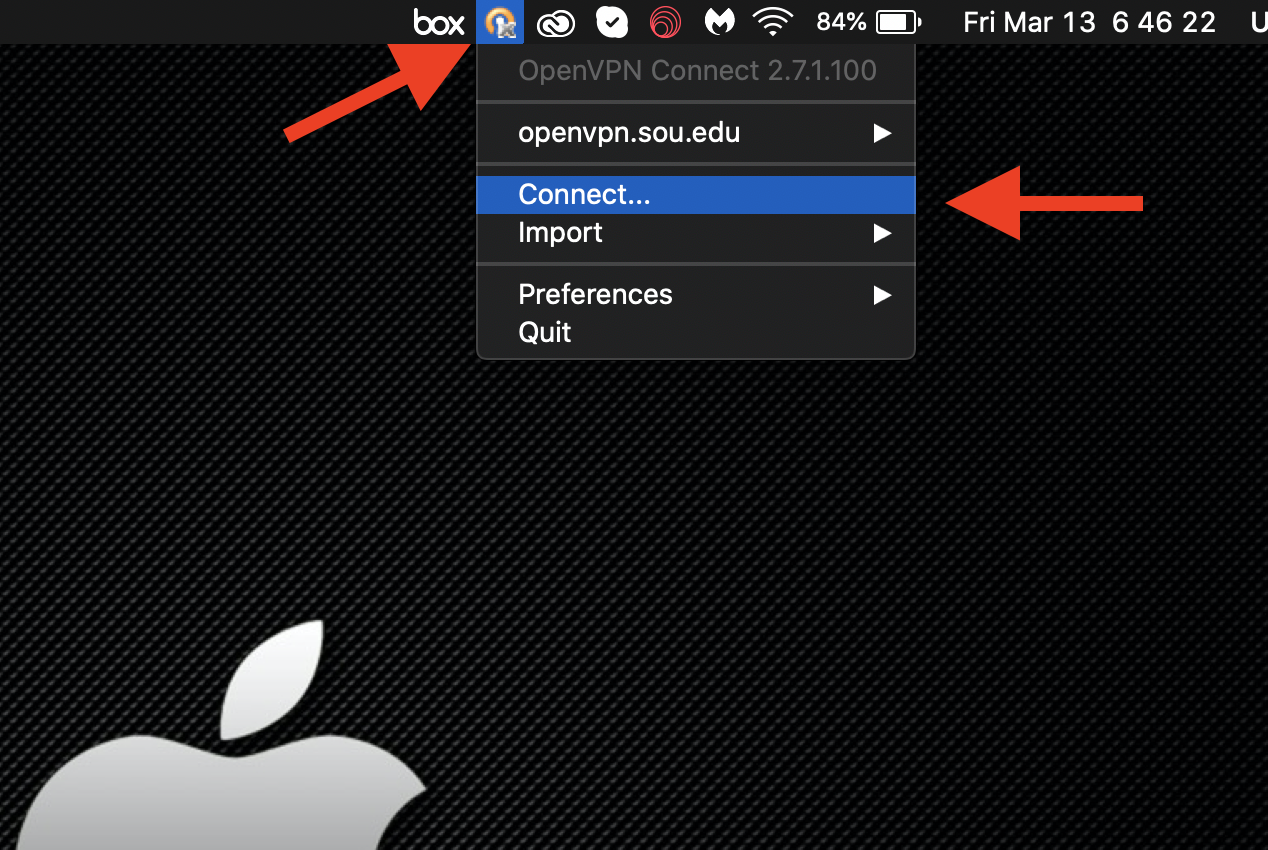
Enter openvpn.sou.edu into the prompt and then click Connect.
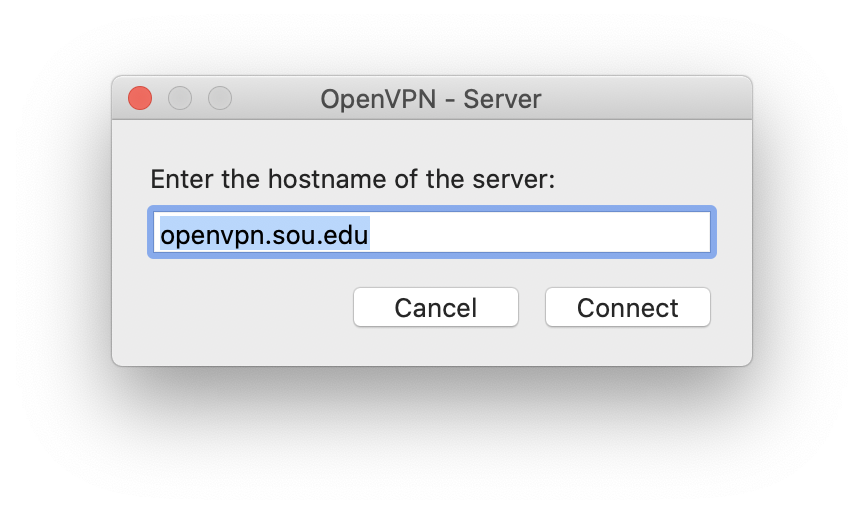
On the next screen, enter your SOU credentials and then click Connect.
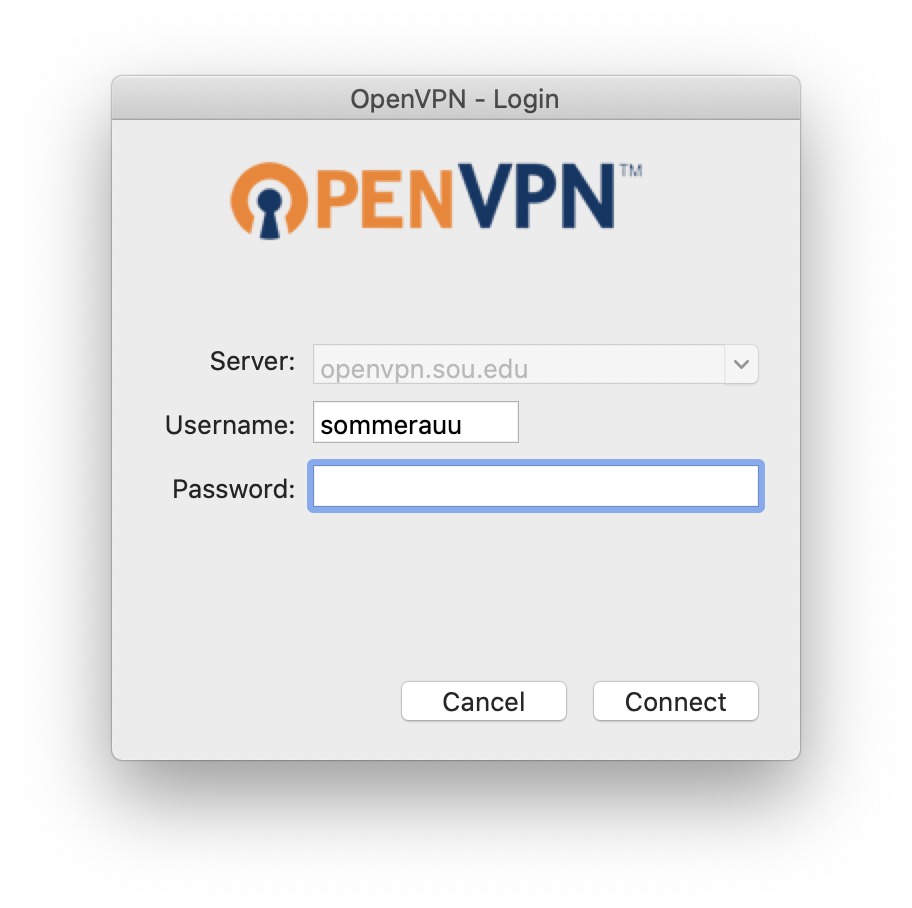
After you have provided your credentials, you will be required to complete your authentication with Duo. If you do not have a Duo device that you can access away from your office, contact your Computing Coordinator immediately or follow these instructions to self-enroll another Duo device, such as a cell phone or a home phone.
You may enter any of the following into the text field, then click Continue, to complete this step (don't include any quotation marks). If you have more than one phone enrolled in Duo, you can append "2" or "3" (or higher) to the push option, the sms option, and the phone option to refer to that device specifically. (Example: push2, phone2, sms2; push3, phone3, sms3) Because it is difficult to know which phone is identified by which number, we recommend that you start with no numbers, then append "2", then append "3" if "2" does not work, and so forth until you receive the push notification, the text message, or the phone call on whichever phone you have access to at the time.
- "push" - Enter this to receive a push notification from Duo on your enrolled smart phone.
- "sms" - Enter this to receive a text message from Duo on your enrolled smart phone or cell phone.
- "phone" - Enter this to receive a phone call from Duo on your enrolled smart phone, cell phone, or desk phone.
- token code - If you have a Duo token or want to use a passcode stored in the Duo app on your smart phone, enter the code in the text field.
You will know that you have successfully connected when the OpenVPN Connect icon in your menu bar updates with a green check mark.
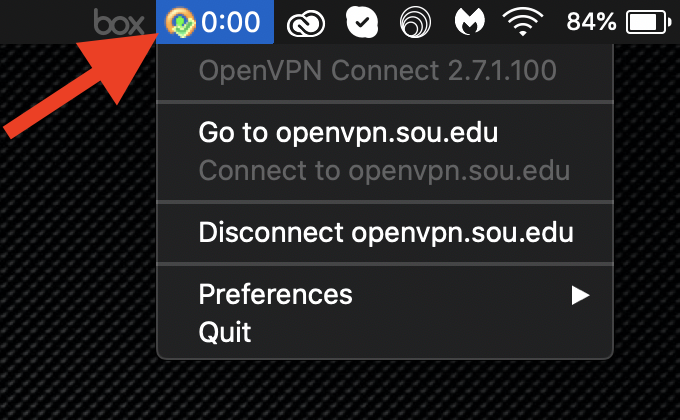
Step 2 - Connect your SOU Network Drives (P, S, and X)
After you have connected to the VPN service on your Macintosh, you can manually connect your SOU network drives as you normally would by following these instructions.
How to Disconnect from the VPN Service
When you are finished with your work, please disconnect from the VPN service to free up resources for other users.
 Windows Instructions
Windows Instructions
You can disconnect by clicking on the OpenVPN Connect client icon in the notifications area, then select Disconnect openvpn.sou.edu from the menu. (Note: You do not need to Exit the client entirely, but you can if you want to. It will disconnect your session before it closes.)
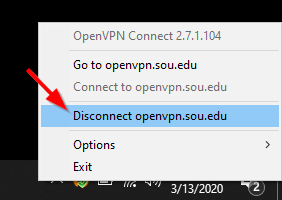
You will receive a notification from Widows that you are now disconnected from the VPN service. The OpenVPN Connect icon will also change back to its disconnected state.
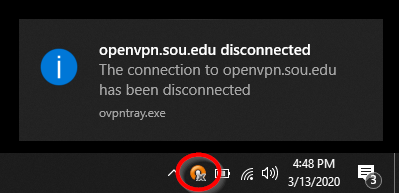
 Macintosh Instructions
Macintosh Instructions
Click on the OpenVPN Connect icon in your menu bar, then click Disconnect openvpn.sou.edu from the menu.
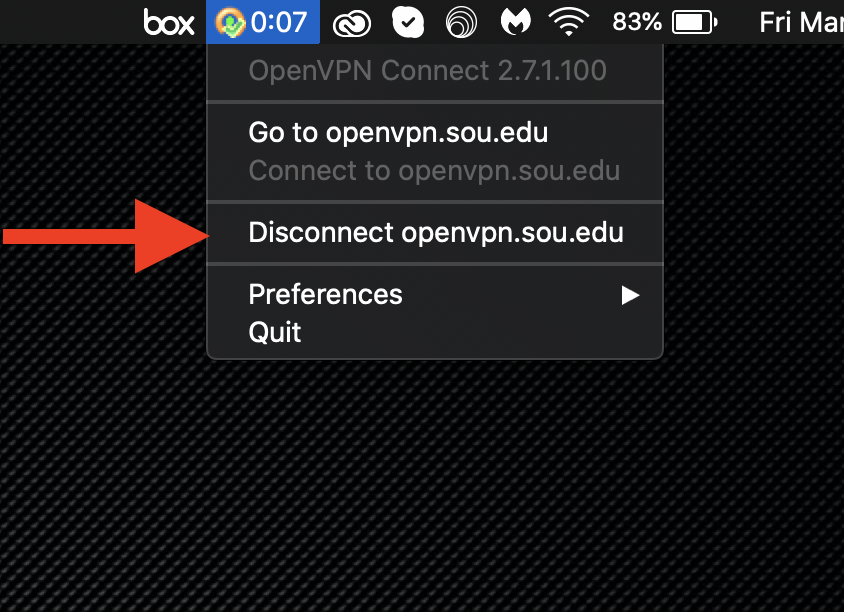


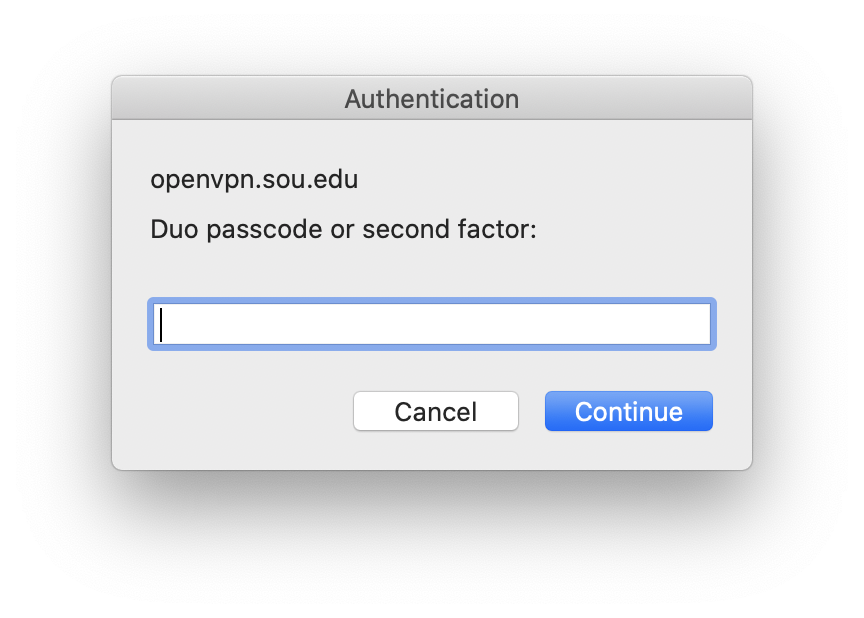
Add a comment
Please log in to submit a comment.